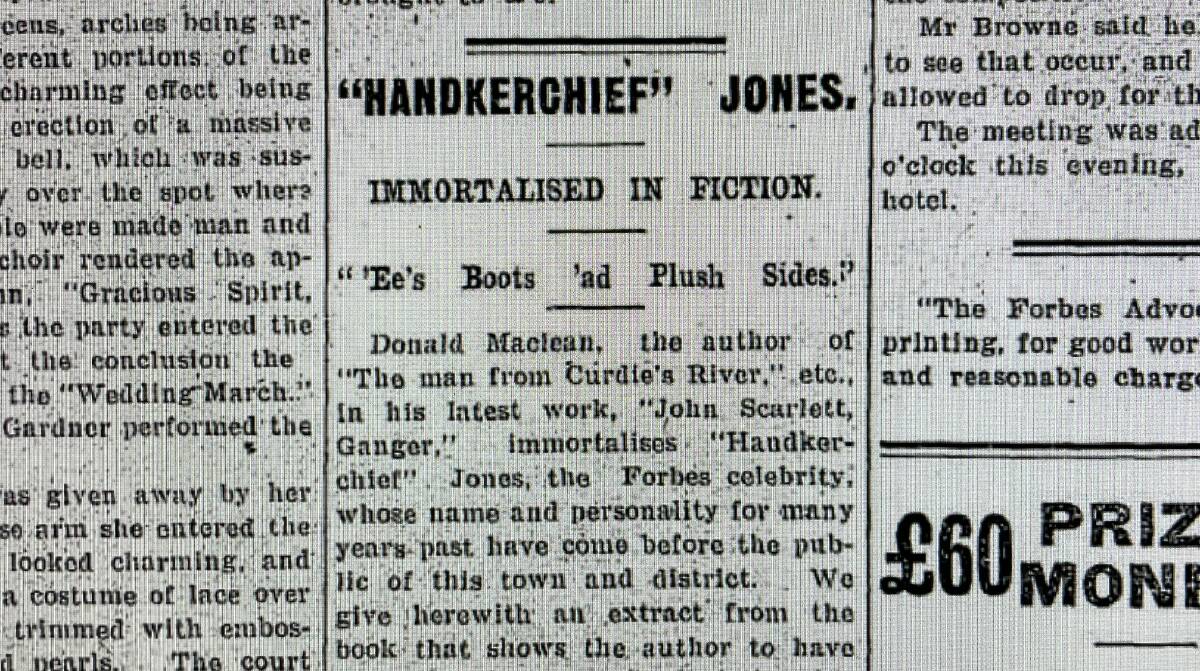
Another look at local papers from the past, featuring some colourful local characters that may have faded from the community memory.
Subscribe now for unlimited access.
or signup to continue reading
This week we look pre-World War I, when a man named Handkerchief Jones was inspiring writers ranging from Banjo Patterson to the Advocate's court reporter.
"Did you ever come across a chap called 'Andkerchief Jones, Ted?" "Did I wot? I reckon everybody that ever worked in New South Wales knows 'Ankerchief!"
So claimed author Donald Maclean in "John Scarlett, Ganger", but a century later few of us have heard of the "Forbes celebrity".
A good thing he is immortalised in fiction - by Mr Maclean and Banjo Patterson - as it sounds as though he was a colourful character.
The Forbes Advocate in 1915 published this excerpt from John Scarlett, Ganger, reporting that it was a "well informed" depiction of Forbes' own Mr Albert Jones:
"Ee's boots 'ad plush sides in them - blue on one side, red on the other - an the photo of 'ee's girl done on a medallion let in on the toecaps. "'e wears a watchguard as big as a bullock chain right across 'ee's chest, with a medal or somethink hangin' onto every link.
"'e wears as many decorations as a tram conduction. e's fingers are covered with rings - Brummies most of them though - an' 'e always wears a very gay silk 'ankerchief round 'ee's neck".
Banjo Patterson had heard the same story, it seems, when he referenced him in "The Shearer's Colt".
"Handkerchief Jones earned his name because of his three guiding principles in life which were 1) he always wore a silk handkerchief around his neck 2) he always took his boots off to fight and 3) he never took his hat off to a lady."
The Advocate's court reports do not record the life of Mr Jones so favourably.
A search of the National Library of Australia's Trove turns up offences ranging from offensive language to cruelty to a horse, break and enter and failing to provide for his wife and two young children.
The Orange Leader of 2 March 1914 reported the following:
This Forbes notoriety has again been giving the Forbes police more trouble. He was wanted for cruelly illtreating a horse and a warrant issued for his arrest, but his whereabouts could not be located until Constable Coleman spotted him near the Forbes brewery a day or two ago.
Having had some experience with him before, the constable went back to the lockup for assistance, but Jones, although his shirt sleeves were rolled up and displaying a pair of well sunbrowned muscular arms, thought better of tackling the pair of young policemen and went quietly. He was remanded, bail being fixed at 100 pounds.
Mr Jones died in 1916 of typhoid fever and pneumonia, while his children were still very young.
His passing was reported in Sydney papers and a Grafton barber submitted an article to the local Examiner, saying that "By the death of Handkerchief Jones the shearing sheds and camp fires have of the great hinterland have lost one of the figures that, each in their own small way, add to the romance of the bush and form the basis of the innumerable yarns that, true or imaginary, the story-tellers of the west delight to tack onto them".
The following was published in a number of papers in 1923 ...
He was recognised, far and wide, by always appearing in public with his neck encircled in a gorgeous red, white and blue handkerchief, a generous display of a green and white one protruding from one of his coat pockets and a third, gaily decked with flowers, showing from a second pocket.
From boyhood it was his habit to 'mix it' on every convenient occasion and it was the regular habit of his admiring mother to reward his frequent victories with a threepenny bit.
These trophies were stored away and eventually strung together as a watch chain which he wore with considerable pride.
As it is a poor man whose mother won't back him against the world, Handkerchief Jones' mother never observed a fight in progress without pushing her way into it in the hope that her boy was one of the contestants. If he was he had his mother in his corner and she made an enthusiastic and loyal second.
Handkerchief Jones lived in the notorious Brewery Lane - behind today's McDonalds.
The area was so regarded that a facetious article appearing in the Advocate in 1919 warned that anyone returning from Parkes later than midnight would be "likely sentenced to live in Brewery Lane".
Like Handkerchief, the locality features regularly in the court reports of the day. One article is published in full below, from The Forbes Advcate of Tuesday 7 September 1915.
In addition, Arthur Wright and Reg Baldock told their recollections of Handkerchief Jones to Rob Willis before they passed away. These recordings are kept in the National Library of Australia.
If you'd like to learn more go online to trove.nla. gov.au

